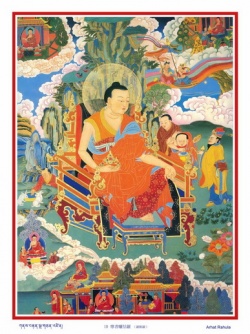Ratana Sutta
The Ratana Sutta (Burmese: ရတနသုတ်) is a Buddhist discourse (Sanskrit sutra Pali, sutta) found in the Pali Canon's Sutta Nipata (Sn 2.1) and Khuddakapatha (Khp 7); with a parallel in the Mahavastu. In the Pali it is seventeen verses in length, and in the Sanskrit version nineteen. The Ratana Sutta extols the characteristics of the three ratana (Pali for "gem" or "jewel" or "treasure") in Buddhism: the Enlightened One (Buddha), the Teaching (Dhamma) and the noble community of disciples (ariya Sangha).
Background
In Theravada Buddhism, according to post-canonical Pali commentaries, the background story for the Ratana Sutta is that the town of Vesali (or Visala) was being plagued by disease, non-human beings and famine; in despair, the townspeople called upon the Buddha for aid; he had the Ven. Ananda go through town reciting this discourse leading to the dispersal of the town's woes.
Contents
The Ratana Sutta upholds the Three Jewels as follows:
the Buddha as the unequalled Realized One (verse 3: na no samam atthi Tathagatena)
the Teaching (dhamma) of:
Nirvana (verse 4: khayam viragam amatam panitam), and
the unsurpassed concentration (verse 5: samadhim) leading to Nirvana
the noble Community (ariya sangha) for having:
attained Nirvana (verses 7: te pattipatta amatam vigayha),
realized the Four Noble Truths (verses 8-9: yo ariyasaccani avecca passati), and
abandoned the first three fetters (verse 10: tayas su dhamma jahita bhavanti) that bind us to samsara.
Use
In Theravada countries and institutions, this discourse is often recited as part of religious, public and private ceremonies for the purpose of blessing new endeavors and dispelling inauspicious forces.
